Xiaomi has more Indian than local handset companies, says Manu jain
By MYBRANDBOOK

The Xiaomi India MD, Manu Jain said his company was more Indian than Indian handset companies. It made all its smartphones and most of its smart TVs here and sourced, on average, 65% of its components locally. It has a completely local leadership, and has generated employment for 50,000 people. “And 100% of the data of Indian users stays in India,” he said.
Xiaomi has seven manufacturing facilities - the biggest ones at the Sri City special economic zone in Andhra Pradesh and at Sriperumbudur in Tamil Nadu. The company has also partnered with contract manufacturers including Flex, Foxconn and Dixon. Jain said non-Chinese foreign rivals including one ‘US company’ imports all of their phones from China and local Indian brands only relabel and sell in India.
“People are talking about US brands, but forgetting that US branded phones are 100% made in China, every single component, and they’re just importing to India…There were so-called Indian brands...who didn’t even change the home screen; they just changed the logo and called it an Indian phone,” he said.
In the aftermath of the June 15 Galwan Valley clash, in which 20 Indian army men were killed by the Chinese, social media platforms have been buzzing with ‘boycott Chinese Products' campaigns with incidents being reported in some parts of the country. For example, slogans were raised outside two Xiaomi stores in the past week while rival Oppo’s factory in Greater Noida saw protests for a couple of hours last Saturday.
In Box: Jain said non-Chinese foreign rivals including one ‘US company’ imports all of their phones from China and local Indian brands only relabel and sell in India.
The anti-China sentiment prevailing in the country has not hurt Xiaomi’s sales yet. The company sold 10 million units in the January-March period to hold on to a 31.2% share, as per IDC. Vivo and Samsung trailed in the second and third positions.The company has been struggling to meet pent-up demand post-lockdown, he said, adding that it had been forced to import devices.
“The biggest challenge is the availability of manpower. It’s not only for manufacturing, even at warehouses, delivery boys, after-sales service centres, shop boys…We have been importing during the month of June because manufacturing is still taking time to ramp up and demand is extremely high,” said Jain.
“Luckily for us, a lot of our manpower was from local villages and not from other states and since 95% of our workforce in factories are women, we had already built dormitories…as long as the government regulations allow them, we should be able to ramp up hopefully, faster than many other people in the industry.” Jain said.


Nazara and ONDC set to transform in-game monetization with ‘
Nazara Technologies has teamed up with the Open Network for Digital Comme...

Jio Platforms and NICSI to offer cloud services to government
In a collaborative initiative, the National Informatics Centre Services In...

BSNL awards ₹5,000 Cr Project to RVNL-Led Consortium
A syndicate led by Rail Vikas Nigam Limited (abbreviated as RVNL), along wi...

Pinterest tracks users without consent, alleges complaint
A recent complaint alleges that Pinterest, the popular image-sharing platf...


Icons Of India : ASHISH KUMAR CHAUHAN
Ashish kumar Chauhan, an Indian business executive and administrator, ...

Icons Of India : Anil Agarwal
Anil Agarwal, the Founder and Chairman of Vedanta Resources Ltd., is r...

ICONS OF INDIA : SANTHOSH VISWANATHAN
Santhosh Viswanathan is the the Vice President and Managing Director f...


HPCL - Hindustan Petroleum Corporation Ltd.
HPCL is an integrated oil and gas company involved in refining, market...

GeM - Government e Marketplace
GeM is to facilitate the procurement of goods and services by various ...

LIC - Life Insurance Corporation of India
LIC is the largest state-owned life insurance company in India...


Indian Tech Talent Excelling The Tech World - Soni Jiandani, Co-Founder- Pensando Systems
Soni Jiandani, Co-Founder of Pensando Systems, is a tech visionary ren...

Indian Tech Talent Excelling The Tech World - Vinod Dham, Founder & Executive Managing Partner, IndoUS Venture Partners
Vinod Dham, known as the “Father of the Pentium Chip,” has left an...

Indian Tech Talent Excelling The Tech World - Dheeraj Pandey, CEO, DevRev
Dheeraj Pandey, Co-founder and CEO at DevRev , has a remarkable journe...